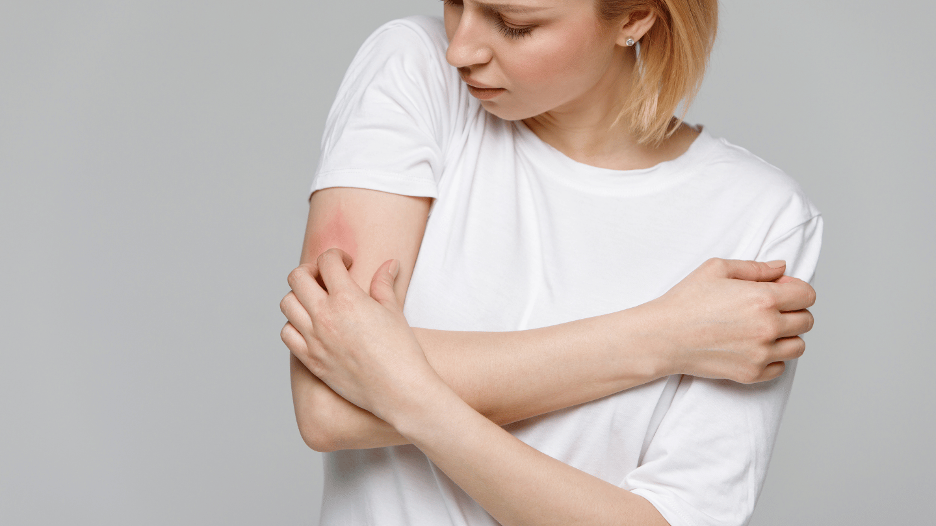
Spider bites: home treatment tips and when to get medical help.
You spot a red, swollen bump on your arm and start wondering, was it a spider bite? Or just another pesky mosquito? Most spider bites won't cause serious problems, but figuring out what actually bit you (and whether it needs attention) isn't always straightforward.
Spider bite symptoms can vary from mild itching to noticeable swelling and tenderness. And unlike mosquito bites, which tend to be small and itchy, spider bites may show up with two tiny puncture marks or a more inflamed, painful area.
This guide breaks down how to tell a spider bite from other bug bites, covers the warning signs you shouldn't ignore and gives you practical steps for treating bites at home, plus clear guidance on when it's time to head to CityMD for professional care.
What does a spider bite look like? Key signs to watch for.
Identifying the source of that bump on your skin can be tricky, since spiders, mosquitoes and other insects can all leave their mark. But recognizing spider bite characteristics helps you determine your next steps and whether medical attention might be necessary.
Typical spider bite symptoms include:
- A raised, reddish or pink bump that might have a tiny puncture mark at its center
- Swelling that can expand beyond the initial bite area
- Sensations ranging from itching to tenderness or even burning
- Occasional blistering or broken skin around the bite
- Warmth radiating from the affected area
Most people experience relatively minor symptoms that fade over several days. However, spider bite swelling sometimes worsens rather than improves, particularly when you scratch the area or experience a mild allergic response.
Wondering whether it's a spider or mosquito bite? Mosquito bites typically remain small, create more itching than pain and cause minimal swelling or discomfort. Spider bites tend to be more painful, show greater inflammation and may develop into an open sore.
When in doubt, don't hesitate to seek professional evaluation, particularly if the bite area changes in appearance, size, or pain level over time.
How to identify spider bites: common types and warning signs.
Knowing what spider bit you helps determine if you need medical care. Here's a quick guide to identify dangerous vs. harmless spider bites.
Dangerous spiders: seek medical care immediately.
Black widow spider bites:
- Spider. Shiny black with red hourglass marking
- Bite symptoms. Sharp pain, muscle cramps, difficulty breathing
- Found. Dark spaces like garages, woodpiles, basements
Brown recluse spider bites:
- Spider. Brown with violin-shaped marking on head
- Bite symptoms. Bull's-eye pattern, delayed pain, tissue damage
- Found. Closets, attics, undisturbed areas
Common harmless spiders.
Wolf spider bites.
- Spider. Large, brown/gray, hairy body
- Bite symptoms. Mild pain and redness, heals in 1-2 days
- Found. Gardens, under rocks, hunting on the ground
House spider bites.
- Spider. Small, brown, round body
- Bite symptoms. Minor swelling, like a mosquito bite
- Found. Indoor corners, closets
Quick first-aid tips for minor spider bites.
If your spider bite isn’t showing signs of serious symptoms, like severe swelling, spreading redness, or a fever, you can usually treat it safely at home.
Here’s how to manage mild spider bite symptoms and help your skin heal:
- Clean the area gently with soap and water to reduce the risk of infection.
- Apply a cold compress to help reduce swelling and ease any burning or itching.
- Use over-the-counter creams like hydrocortisone or antibiotic ointment to soothe the bite and prevent bacteria from spreading.
- Take an antihistamine if the itching is intense or interfering with sleep.
- Keep it covered with a clean bandage if the skin is broken or you’re spending time outdoors.
- Avoid scratching, even if it’s tempting. Scratching your spider bite can increase swelling and raise your risk of infection.
Most minor bites will improve in a few days. But if you notice the swelling getting worse, the bite becomes more painful, or new symptoms develop, it might be time to visit urgent care for a closer look.
When a spider bite needs professional treatment.
You should visit your local CityMD urgent care if:
- The bite becomes very swollen, red, or painful
- You see signs of infection, like pus, warmth, or spreading redness
- You develop new symptoms like fever, chills, or body aches
- A blister or open sore forms and isn’t healing
- The bite is near your eye or on a sensitive area like your face
- You suspect a bite from a black widow or brown recluse
Trust your instincts. When uncertainty arises, professional evaluation proves worthwhile. This becomes important if your symptoms persist beyond a few days or if you notice worsening spider bite swelling or increasing discomfort.
Our CityMD team can properly clean wounds, address infections and provide prescription antibiotics or pain management when necessary. We're committed to helping you recover quickly and safely, eliminating any guesswork from your treatment.
Get expert spider bite treatment at CityMD.
What begins as a seemingly minor spider bite can sometimes develop into something requiring attention, especially when redness starts spreading, swelling persists, or you're left wondering what actually bit you.
Getting it evaluated makes good sense in these situations. Understanding how to distinguish between routine spider bite symptoms and warning signs of serious reactions helps you prevent complications while getting back to feeling your best more quickly.
From minor bumps to bites that won't heal properly, CityMD stands ready to assist. You can walk in anytime to your local CityMD location or schedule a virtual visit with us for prompt, professional care.

We’re ready to care for you.
Visit any CityMD urgent care location in your community today for an evaluation with one of our expert providers.